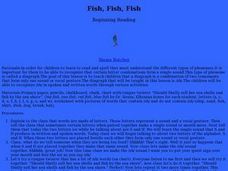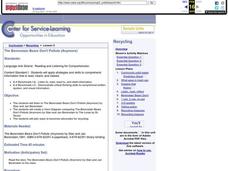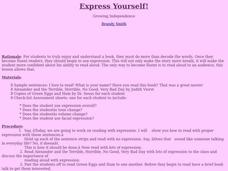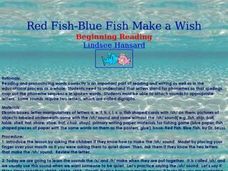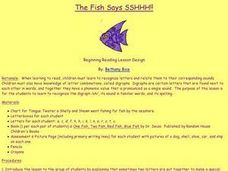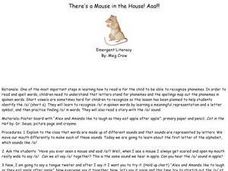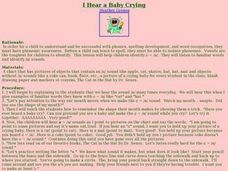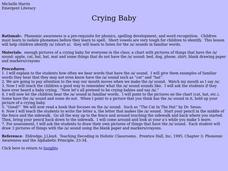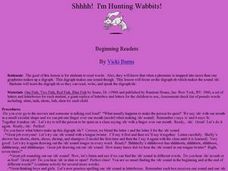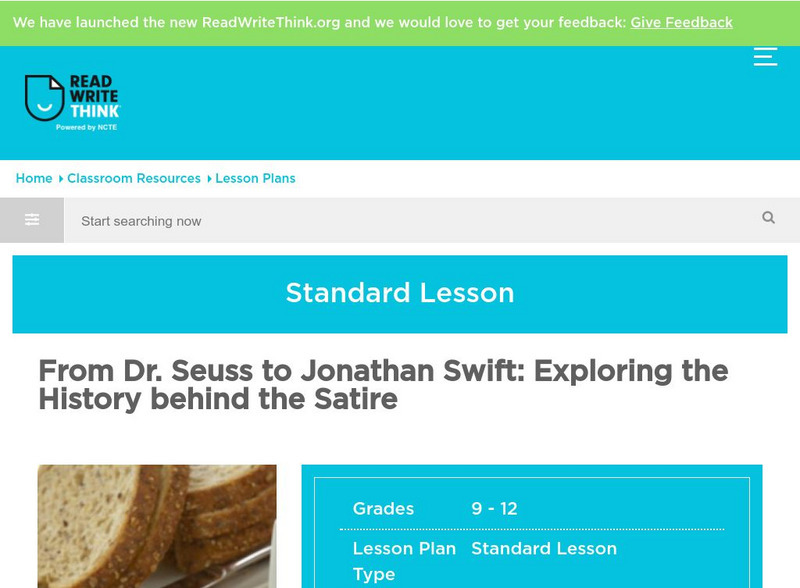Curated OER
Fish Wish
Students identify the digraph /sh/ in written and spoken language. After a reading of a decodable story containing the digraph, students practice identifying the initial and final placement of the new digraph /sh/ in words using a...
Curated OER
Shhhhh
First graders identify the digraph /sh/ in written and spoken language. After a brief discussion of the independent and combined sounds of the phonemes /s/ and /h/ students practice identifying initial and final placement of the new...
Curated OER
Tick Tock Goes The Clock
Students practice letter recognition in written language and sounds for /t/ in both the upper and lower case forms. They utilize a chart with "Today Teddy talked to ten people at two o'clock," on it while making the sounds that are...
Curated OER
Fish, Fish, Fish
Students identify the digraph /sh/ in written and spoken language. After a brief discussion the independent and combined sounds of the phonemes /s/ and /h/ students practice identifying initial and final placement of the new digraph /sh/...
Curated OER
Go Fish
First graders explore rhyming words. They listen to the book One Fish, Two Fish, Red Fish, Blue Fish and discuss the rhyming words. After being placed into groups, they play the game, "Go Fish" and find matching rhyming words. They...
Curated OER
Horton Hears a Who
Students explore the ways that communities work in the story Horton Hears a Who and compare that to the community in which they live.
Curated OER
The Berenstain Bears Don't Pollute (Anymore)
Students listen to the story, The Berenstain Bears Don't Pollute (Anymore). They create a Venn Diagram comparing it with the story, The Lorax. Then students plan ways to become advocates for recycling.
Curated OER
Particulate Matter: The Lorax
Students collect air samples to test it for air pollution. They are read the story The Lorax and discuss the effects of air pollution. They share their observations with the class.
Curated OER
Say aahhh....said the doctor
Students recognize the short vowel O in written and spoken language. Through matching activities, they discriminate the short vowel /o/ from other vowel sounds. Students associate the phoneme with its letter representation and identify...
Curated OER
Express Yourself
Students practice reading with expression. After discussing how reading with feeling and expression can enhance the text, students listen as their partner reads a story with expression. Individual students complete a reading assessment...
Curated OER
Red Fish-Blue Fish Make a Wish
Students to read and pronounce words correctly. They investigate the letters that stand for phonemes so that spellings map out the phoneme sequence in spoken words. Students attach sounds to appropriate letters. They have some sounds...
Curated OER
The Fish Says SSHHH!!
First graders identify the digraph /sh/ in written and spoken language. After a brief discussion the independent and combined sounds of the phonemes /s/ and /h/ students practice identifying initial and final placement of the new digraph...
Curated OER
There's a Mouse in the House! Aaa!!!
Students recognize the short vowel a in written and spoken language. Through matching activities, they discriminate the short vowel /a/ from other phonemes. Students associate the phoneme with its letter representation and identify the...
Curated OER
I Hear a Baby Crying
Students recognize the short vowel a in written and spoken language. Through matching activities, they discriminate the short vowel /a/ from other phonemes. Students associate the phoneme with its letter representation and identify the...
Curated OER
Crying Baby
Students explore phonemes. They discuss the short a sound. Students discuss the shape their mouths make when saying /a/. They read familiar words with the /a/. Students read "The Cat In The Hat." They identify words with the short a sound.
Curated OER
Crying Baby Sound
Young scholars recognize the short vowel a in written and spoken language. Through matching and listening activities, they discriminate the vowel sound /a/ from other phonemes. Students identify the phoneme and letter in words from the...
Curated OER
The B Beat
Students recognize letter b in print and respective phoneme /b/ in spoken words, such as tongue twisters. Students then listen for phoneme in spoken words, and practice writing letter b.
Curated OER
Shhhh! I'm Hunting Wabbits!
Students identify the consonant digraph -sh in words and phrases. They practice recognizing the digraph /sh/ through tongue twisters and storytelling. Students read and spell words and pseudowords containing the -sh digraph.
Varsity Tutors
Varsity Tutors: Web English Teacher: Dr. Seuss Lesson Plans
What is your favorite Dr. Seuss story? Web English Teacher may be offering you resources to teach it right here! Also contains links to biographical information.
ReadWriteThink
Read Write Think: From Dr. Seuss to Jonathan Swift
Contains plans for three lessons that use Dr. Seuss?s "The Butter Battle Book" to introduce satire in Jonathan Swift?s "Gulliver?s Travels." In addition to objectives and standards, this instructional plan contains links to PDF handouts...
ReadWriteThink
Read Write Think: Dr. Seuss's Sound Words Playing With Phonics and Spelling
Contains plans for three lessons that teach about sound and letters using Dr. Seuss's "Mr. Brown Can MOO! Can You?" In addition to objectives and standards, this instructional plan contains links to sites used in the lessons as well as...
Alabama Learning Exchange
Alex: It's Your Birthday, Dr. Seuss!
This lesson plan is intended to be used during the month of March when the class is preparing to celebrate Dr. Seuss Day. After listening to and reading different stories by Dr. Seuss, the students have opportunities to compare and...
ArtsNow
Arts Now Learning: Dr. Seuss Is on the Loose [Pdf]
The rhythmic and melodic elements of Theodor Geisel's children's literature provide many opportunities for knowledge of language, vocabulary acquisition and use, and creative expression and communication in music. Young scholars work...
Better Lesson
Better Lesson: Time to Kiss This Nonseuss Goodbye!
In this instructional activity, students will choose their favorite from an assortment of Dr. Seuss books and state a reason why for their choice. Examples of student work are included. Students will also have fun dressing up as their...
Other popular searches
- Lessons From Dr. Seuss
- Free Dr. Seuss Lessons
- Lessons From Dr Seuss
- Dr. Seuss Lessons Numbers
- Free Dr Seuss Lessons





